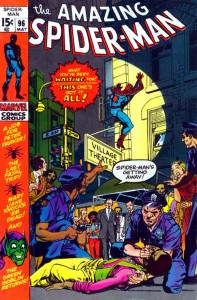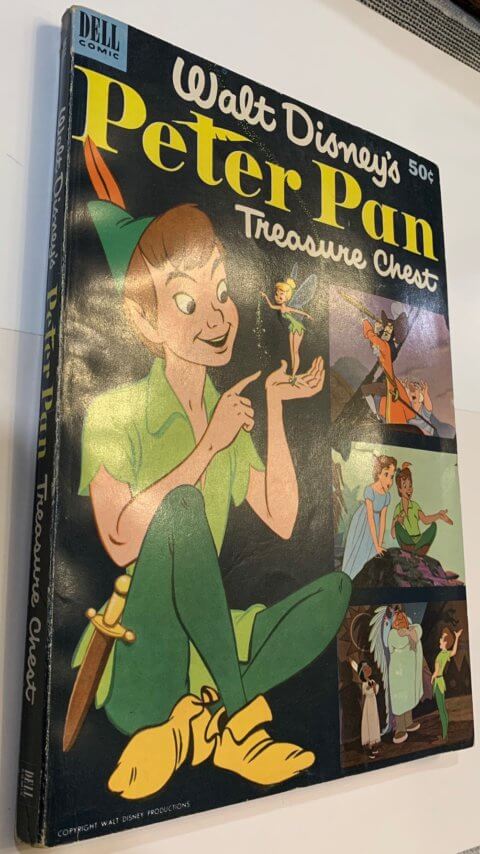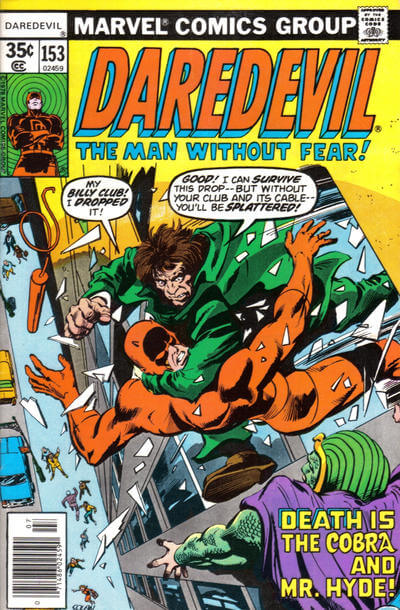 This week I am turning the Undervalued Spotlight reigns over to guest writer Nelson da Rocha. Nelson is arguing that Amazing Spider-Man #96 deserves better than it is currently getting and I agree. Nelson gets to the heart of something I’ve briefly touched on in my Undervalued Spotlight #84 and #99.
This week I am turning the Undervalued Spotlight reigns over to guest writer Nelson da Rocha. Nelson is arguing that Amazing Spider-Man #96 deserves better than it is currently getting and I agree. Nelson gets to the heart of something I’ve briefly touched on in my Undervalued Spotlight #84 and #99.
Comic book history contains pivotal issues whose unforeseen repercussions set off chain reactions that truly shaped the comic book world and I’ll back Nelson’s arguments that ASM #96 is one such book. Let’s turn things over to Nelson.
Over the past decade I’ve really taken a different approach to how I view comics and it started with Civil War. Although I was ultimately disappointed in how Marvel’s Civil War ended considering how much I enjoyed the opening, regardless, I appreciated that this was a series that reflected our times. It wasn’t that long ago but that ‘period’ post 9/11 was pretty screwed up, socially and politically (and we’re still dealing with the ramifications of security vs. Freedom) and Civil War did a fairly successful job of, at least, capturing the America’s tone.
I remember hearing stories when I was younger about Japanese Internment camps during World War 2 and asking myself, ‘how could people let this happen when it’s clearly violating people’s human rights?’ The answer, as it turns out, is, ‘very easily’. That’s what Civil War’s greatest contribution is. The tone of the opening issues captures the bizarre zeitgeist quite nicely. So much so that I believe thirty years from now people can look back and say, ‘if you want an idea of the climate of post 9/11 America, watch movie X, read book Y, and check out Marvel’s Civil War for an interesting take on things.’ But that got me thinking, how do past comics reflect the times they were created in? When you look at comics via their supposed ‘Ages’ (that is Golden, Silver, Bronze, etc.) you see interesting patterns develop. Notable shifts in tone are almost subtle in some cases but blunt in others.
Again, like Civil War, comics in these ages could only have been created during these times – and I’ve really developed a whole new appreciation for them. Early Silver Age reflects a wonderful tone of the Nuclear Age. There’s an inspiring sense of, ‘the future has no limits’, but as the years go on and the Cold War heated up, you could almost taste the paranoia, propaganda and patriotism.
We could go on about the Silver Age forever but my favourite age of comics is quickly becoming the Bronze Age. Comics really do grow up during this period, and I don’t mean to sound pretentious, but when you consider that Batman ’66 was a reflection of comics at the time, not surprisingly, comics took a decidedly different direction. What I enjoy the most about Bronze Age comics is, once again, the tone is a reflection of the times. Social concerns are now prominent, heroes with questionable morals become popular, minority characters are more frequent, and horror comics make a resurgence.
Now with all that being said, this comes from the Wikipedia entry for Bronze Age of Comics: There is no one single event that can be said to herald the beginning of the Bronze Age. Instead a number of events at the beginning of the 1970s, taken together, can be seen as a shift away from the tone of comics in the previous decade.
That’s interesting but I completely disagree. Simply put, Amazing Spider-Man #96 is, flat out, one of the most important comic books ever made and it’s all because of the Comics Code Authority. Quick overview for those unfamiliar, the Comics Code Authority or CCA was a body created by publishers to self-regulate content released in comics. It was the product of a moral panic during the mid 50’s created by psychiatrist Fredric Wertham’s book Seduction of the Innocent, which outlined a link between juvenile delinquency and comic books. Comics became public enemy number one, leading some cities to organize public burnings. Hence, publishers agreed to self-regulate via an authority following a set of agreed upon rules. Some of these rules were:
- There shall be no presentation of “policemen, judges, government officials, and respected institutions … in such a way as to create disrespect for established authority.”
- “In every instance good shall triumph over evil”.
- There may be no “instances of law enforcement officers dying as a result of a criminal’s activities.”
- Imagery of kidnappings and concealed weapons were not allowed as well as “lurid, unsavory, and gruesome illustrations.”
- Vampires, werewolves, zombies and ghouls were not allowed.
- HORROR, and TERROR were not allowed in titles.
- Love and romance stories had to enforce the “sanctity of marriage”.
Yeah, I think we can all agree these are terrible, but it did allow for some creative storytelling and helped build the underground comics scene. As suffocating as these rules were, it was only a matter of time before they changed – and it changed with this issue.
As the story goes Stan Lee was approached by the Department of Health to do a story about drug use. He did and it was immediately rejected by the CCA. Marvel went ahead and published the issue without the CCA Seal of Approval. Marvel’s initial request in late 1970 to print this issue was denied but did trigger a review of the code which led to the loosening of some restrictions on Feb 1971. The industry quickly took advantage. You can look at the titles available in the 1970’s to see how those changes came about.
For the actual issue itself, let’s be fair, it’s a pretty unremarkable Green Goblin story. Written by Stan Lee with art by Gil Kane and John Romita, this is the first of a three part story arc; the next two issues also not receiving CCA approval.
Now here’s what I find interesting, a 9.2 of this issue is listed for $200 in guide. I’ve seen it go for much less in shops. I managed to pick up a VF on eBay for $30, and I’ve seen it go for less. Did you read that? I picked up a comic that, if it had never happened when it did, our beloved comics industry would be very different, for $30.
Would the Punisher still have been created? Maybe…
Would Gwen Stacy still have died? Maybe…
Would Speedy be doing heroin on the cover of Green Arrow/Green Lantern? Nope!
Howard the Duck? Luke Cage? Marvel’s horror line? Possible, but what would they look like?
How would this have affected the underground comics?
Would there have been a Conan the Barbarian film starring Arnold Schwarzenegger? …yeah think about that. Granted, Conan as a comic launched before the CCA revisions were made, but would it have been as popular if it adhered to the CCA code of 1954? And as per director John Milius, this film only exists because of the popularity of Marvel’s Conan comics.
Now don’t get me wrong, I’m not saying these things wouldn’t have happened if ASM #96 never came out, nor am I ignorant of the role direct market distribution played – what I’m saying is if they did, they would look very different than what we’re familiar with.
A big part of the comic industry we have today was shaped by the direction taken after Amazing Spider-Man 96 was released.
The 43rd edition of the Overstreet Comic Book Price Guide shows $66/$138/$210 as the 8.0/9.0/9.2 price split.
Strengths that make this comic book a good long-term investment are:
- No CCA approval code led to the revision of set rules that told publishers what they could and could not publish
- $210 for a 9.2 but I routinely see it go for much less.
- Classic Green Goblin story.




Definitely a good book to spotlight! It’s a book that has it’s place on comic book history alright.
Solid pick for the spotlight. It wiil always be best remembered for the act of publishing without the comic authority code. This was very popular with teens and young adults at the time because it was considered an “anti-establishment” act. Anything against the status quo was good, and in this case deservedly so! The drug story itself and the Green Goblin appearence were very secondary. A good book to own.
Part of the reason why I think this is far more important than people give it credit for is because of the impact it had afterwards and the themes it reflects.
A big change in the Silver Age was the direction it took with superheroes having a sci-fi background. I have to wonder, would that have happened if Sci-fi wasn’t as popular in theaters and pulp fiction mags?
Interestingly enough, I watched a documentary on CBC recently on superstitions and about how as science and technology have become more prominent, people have become more superstitious – I wonder if this is something we’ll later see as a resurgence in magic themed superheroes and stories in comics.
The gist is, it’s really interesting seeing cultural impacts on comics, and it’s kind of something you don’t see or appreciate until after the fact. It’s one of the reasons why, and I’m about to commit blasphemy, I think the 90’s are horribly underrated.
B96 and A96?
A play on BC and AD: before Amazing Spider-Man 96 and after Amazing Spider-Man 96. Or so I’m guessing…
For years I have referred to Marvel history, and comics history in general, as B96 and A96!
Scott –
You hit the nail on the head!
Good article!
This story, reproduction of the original (in black and white) actually, is also available in IDW’s Gil Kane’s The Amazing Spider-Man Artist’s Edition, along with ASM #97, 98, 99, 100, 101, 102 and cult classic 121 – with death of Gwen Stacy.
Beautiful collection, a “piece” of history in your hands… Which allows you to see the full impact of ASM #96 da Rocha was speaking of.